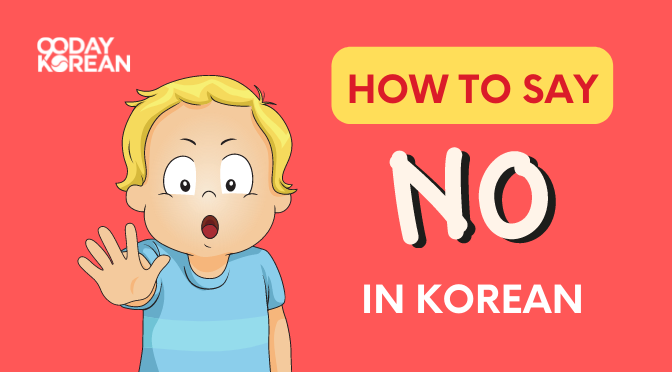In this article, we will teach you how to say “no” in Korean. Hopefully, by the end of this article, you’ll better understand how to use this word, especially during negative situations.
We’ve also included a FREE PDF version of this lesson you can take with you on the go. Check it out below:
How to say “no” in Korean
In Mr. Bean’s Holiday, Mr. Bean travels to France but only knows the French word for “yes.” His inability to say “no” causes all sorts of mishaps. To ensure that your stay in Korea doesn’t end up like Mr. Bean’s trip to France, make sure you learn to say “no” in Korean!
Below are the different ways to say “no” in Korean. But before that, here’s a video lesson that you can watch.
Formal and Standard “No” in Korean
In Korean, the words below are used to say “no” in both formal and standard forms.
아니요 (aniyo)
You can use 아니요 (aniyo) in both formal and standard Korean. This is the most basic form of saying “no” and can be used by itself.
Some alternate spellings that you might see are 아니오 (anio) and 아뇨 (anyo). These mean the same thing, but the correct spelling is 아니요 (a-ni-yo). Therefore, use this spelling when you use the word.
Example:
A: 김치를 좋아해요? (gimchireul joahaeyo)
Do you like kimchi?
B: 아니요, 싫어해요. (aniyo, sileohaeyo)
No, I don’t [literally – no, I don’t like it]
아니오 (anio)
This is the old style of saying “no,” often used in traditional Korean dramas. It’s part of an older style of speaking.
Example:
A: 바쁘세요? (bappeuseyo)
Are you busy?
B: 아니오. (anio)
No.
You may hear the “오 (o)” endings in examples like “기다려 주십시오 (gidaryeo jusipsio).”
Informal “No” in Korean
You can use this when talking to your close friends or someone of a similar or younger age to you.
아니 (ani)
If you want to speak in an informal or casual way, you can drop the 요 (yo) from the end of the word and say 아니 (ani).
Example:
A: 김치를 좋아해? (gimchireul joahae)
Do you like kimchi?
B: 아니, 싫어해! (ani, sileogaehae)
No, I don’t [literally – no, I hate it]
What’s the difference between 아니요 (aniyo) and 아니에요 (anieyo)?
Many people get confused about 아니요 (aniyo) and 아니에요 (anieyo) when learning Korean. To clear this confusion, here’s a video explaining the difference between 아니요 (aniyo) and 아니에요 (anieyo).
How to say “it is not” in Korean
As mentioned in the video above, the Korean word used to mean “it is not” is 아니에요 (anieyo).
아니다 (anida) means “not.” This word changes to 아니에요 (anieyo) or 아닙니다(animnida) when speaking formally. It changes to 아니야 (aniya) when speaking informally.
Example (Formal):
A: 일본사람입니까? (ilbonsaramimnikka)
Are you Japanese?
B: 아니요, 일본사람 아닙니다. (aniyo, ilbonsaram animnida)
No, I’m not Japanese.
Example (Standard):
A: 영국사람이에요? (yeongguksaramieyo)
Are you British?
B: 아니요, 영국사람 아니에요. (aniyo, yeongguksaram anieyo)
No, I’m not British.
Example (Informal):
A: 중국사람이야? (jungguksaramiya)
Are you Chinese?
B: 아니, 중국사람 아니야 (ani, jungguksaram aniya)
No, I’m not Chinese.
How to say “No, thank you” in Korean
For a polite way to decline if someone invites you somewhere or offers you something, we usually say, “No, thank you.”You can say “no, thank you” in Korean as 고맙지만 괜찮아요 (gomapjiman gwaenchanayo), which translates to “Thank you, but I’m okay.”
Another way to say it is 고맙지만 사양할게요 (gomapjiman sayanghalgeyo), translating to “Thank you, but I decline.”
If you want to say “Thank you” on its own, you can learn from our article on how to say “Thank you” in Korean.
Other ways to say “no” in Korean
Like the word “yes,” there are ways of saying “no” without using the actual word for “no.” Read the bonus section at the end of this article to learn some of these ways of saying “no.”
By now, you should know how to say “no” in Korean. However, in the Korean language, there are many other words and phrases that would be written as “no” if they were translated into English. Below are some of the more common examples. All of the examples are at the standard politeness level.
“It is not allowed” in Korean
If you want to say “no” in Korean to emphasize that something isn’t allowed, you can use the Korean word 안돼요 (andwaeyo).
Example:
A: 맥주를 주세요 (maekjureul juseyo)
Beer, please.
B: 안돼요! (andwaeyo)
No [literally – it’s not allowed]
“I can’t do it” in Korean
If you want to express that you can’t do a certain thing, you can say 못해요 (mothaeyo).
Example:
A: 수영할 수 있어요? (suyeonghal su isseoyo)
Can you swim?
B: 못해요 (mothaeyo)
No [literally – I can’t]
“It doesn’t exist” in Korean
Lastly, if you want to say “no” when responding to a question if you have something or not, you can use the word 없어요 (eopseoyo). This means that you don’t have it, or the thing does not exist.
Example:
A: 현금이 있어요? (hyeongeumi isseoyo)
Do you have any cash?
B: 없어요 (eopseoyo)
No [literally – it doesn’t exist]
A Word of Caution About Romanization
Romanization means to sound out Korean words using English letters and writing them in this form. This works well if you only need to know a few Korean words.
However, the English representation of Korean words can be pretty confusing! It often frustrates Korean learners since there are many interpretations of how to pronounce Romanized words.
The good news is that you can learn the Korean alphabet in about 1 hour! You can download it here for free.
The sooner you can get past Romanization and reading Hangul, the faster you’ll be able to learn Korean!
Wrap Up
We hope by now you’ll be able to say “no” in Korean, especially when the need arises. Keep listening to how your Korean friends or native speakers give negative answers to help you understand how to say “no” in different situations.
If you’d like to know more about Korean culture next, we have a separate article for it here.






Hello, I wonder how can we say “not really” in korean ? Is that “별로”? Or any other words?
감사합니다 ☺
Hi, Fanny! You can say “전혀”. ^^
Thanks a lot! I’m trying to find out what the girl says in this video: https://youtu.be/uEWGibnWwr0?t=224 (should open at around 3:45)
I think I hear 옵타 but I couldn’t find anything resembling that in the list. What she says is translated as “none” rather than “no”. Thanks for your help!
Hi, Eric! It should be “없다” (doesn’t exist), the last word in this article! In the context of the video, it means “(there’s) no possibility (that they’ll date the person)”. ^^
This website is very good as in it teaches how to correctly say the common phrases very well.
This is my second day of learning Korean and I am grateful that I found this website through your app on Google Play!
I have now learnt 한글 and can read most simpler Korean words! I am still looking for a way to improve my vocabulary tho because I can read them but I do not understand them yet!
감사합니다!
Thanks for your support, Lumina! Here are some tips on how to memorize Korean words more easily! (https://www.90daykorean.com/how-to-remember-korean-words/) Keep going! 화이팅! ^^
This is incredibly helpful stuff! Kamsamida! ^^
No problem, Kaitlin! Thanks for the comment. ^^
Thanks for this!
No problem! Have fun learning Korean. ^^